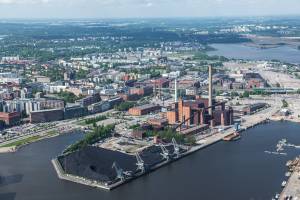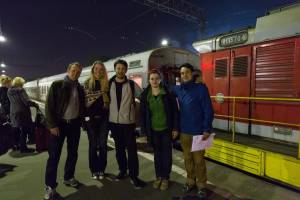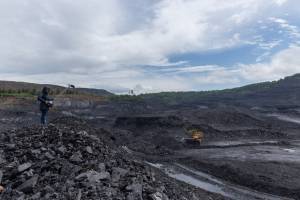We continue to publish the top blogposts from the contest organized by 350.org in EECCA region. The next blogpost by Anastasia Laukkanen is about the very center of Siberia. We all know that what we are thinking today will determine our tomorrow. But the opposite is also true. How we imagine our future determines what we are doing today.
Anastasiya Laukkanen, 20/07-2015. The original version (in Russian) was posted at Bellona website.
In 2009, a Finnish filmmaker whose name, John Webster, would rather suit an English poet, shot an ironic documentary entitled “Recipe for Disaster” about how he forced his family to live without fossil fuels for a year. It was the first cinematic experiment of this kind that was then repeated on film by families from other countries with greater or lesser success. In Finland, the film toured all of the cinemas, the adventurous filmmaker’s wife, poor thing, became something of a national hero, and the idea to arrange the screening in Moscow resulted in an entire “green” film festival.
The story of the Finnish family, of course, didn’t end when the film’s credits rolled. Webster started working on ideas for a sequel almost immediately after it. This time, there were no homemade toothpaste and attempts to self-produce electricity. From counting just how much waste one particular family produces today, Webster moved on to the abstract future. He is shooting his new film for his great-great-great-granddaughter.
Look, can you imagine your future? What will your children’s world be like? Your grandchildren’s? And great-grandchildren’s? With all possible data taken into account, from the world ocean level, its oxidation, temperature, pollution, glacial melting. To the expansion of fossil fuel extraction, population increase and automation, the picture in the minds of those who follow all these data is hardly the most optimistic.
At the same time, Webster understands full well that there’s no way to change our industrial and postindustrial world with just a clap of the hands. Plants aren’t closing down, the methods of coal, oil and gas extraction get dirtier and more dangerous, and urbanization with its machine-TV-air-condition-you-name-it consequences will hardly slow down, either. This situation is sad and displeasing for a responsible and practicing environmentalist. You know everything but you can’t really do anything. This is why John Webster launched this long-term project of a cinematic confession to his great-great-great-granddaughter.
Heap of coal in Helsinki
 The coal arriving in trains from Russia is stored in the open air right in the middle of Helsinki – Photo courtesy of Finnish energy company HELENThe idea to do the shooting in Russia came from a huge heap of coal right in downtown Helsinki. In spite of its countless green aspects, Helsinki is still heated with the coal from Kuzbass. And it will remain so until 2050 (this is the city’s self-imposed deadline to move entirely to renewable energy sources ). And in the meantime, the coal arrives in trains from Russia and lies in the open air right in the middle of the city before everyone’s eyes. Like … loads of coal. And this didn’t make anyone but Webster wonder about it.
The coal arriving in trains from Russia is stored in the open air right in the middle of Helsinki – Photo courtesy of Finnish energy company HELENThe idea to do the shooting in Russia came from a huge heap of coal right in downtown Helsinki. In spite of its countless green aspects, Helsinki is still heated with the coal from Kuzbass. And it will remain so until 2050 (this is the city’s self-imposed deadline to move entirely to renewable energy sources ). And in the meantime, the coal arrives in trains from Russia and lies in the open air right in the middle of the city before everyone’s eyes. Like … loads of coal. And this didn’t make anyone but Webster wonder about it.
“I want to trace the entire path of the coal from Kuzbass to Helsinki.” Webster explained his complicated plan to me on Skype. “We’ll be shooting the functioning mines, talking to the miners, to the mayor of Novokuznetsk, to the chargemen, and then we will take a train and film people in second class and talk to them about the future for four days!”
It was impossible not to join this plan. Although I started wondering about the trip as soon as we began working on the interviews with unsuspecting second-class passengers.

The “Yellow Boots” film crew at Yaroslavsky train station in Moscow, May 20, 2015 – Photo courtesy of John Webster
“How exactly do you want to ask them about the future?”, I kept asking.
“Well, what they think about the global warming and climate change, whether they feel responsibility in from of the coming generations, what they are doing to prevent the environmental catastrophe…” John spoke confidently.
Instantly I remembered how I was filling in an application for some international environmental forum. One of the questions asked to describe in detail what environmental problems my fellow countrymen are concerned with. I got stuck at this question and started calling friends from WWF and Green Peace. Eventually, I answered briefly: “None.” I even gave an explanation.
So, I could only with difficulty imagine us throwing ourselves at people with questions on global climate change. And we decided to take the long way round and ask people about their grandparents first, about the world they lived in, about how they themselves see the world in the future and – attention, we’re trying to ask a question without giving an answer – what problems the future generations will have to deal with.
John waved off my skepticism and joyfully load almost one hundred kilos of filming equipment onto the “Moscow – Irkutsk” train as well as an extra remarkable suitcase with Finnish vodka and chocolate. We were accompanied by a well-known Finnish cameraman, a sound girl with microphone sticks of all kinds, and the crew manager. It was kinda hard not to notice us on the train.
Come what may except war
I’ll say it right away. In his three weeks in Siberia, John Webster hasn’t heard once, one single time from one person, the slightest concern about the global climate change. “I can’t believe this”, John couldn’t stop laughing at himself, “I am making a film about the warming and climate change, and not a single person actually utters these words during the whole trip.”
It turned out that speaking about the future was hard. If ancestors were remembered with pleasure, the next generations beyond the most immediate one were lost in the mist of mystery. I won’t be focusing on the general confidence of males barely in their 50s that their time is over and there’s no need to think ahead (something shocking for Nordic long-livers). Even the familiar (at first sight) story of Mikhail, who began planting peach trees in the garden when retired ended with an unexpected explanation: “Why plant ’em? Well, just for mysel’. I like it, always wanted to have peaches in the garden. What? Grandchildren? Oh no, what would they need my peaches for?”
Without the environmental leads coming directly from us, our train passengers’ main concern for the future could be summarized as “come what may except war.” You can live through the rest. The rest isn’t as scary. Water, woods? Oh, we got plenty of water and woods, we shouldn’t be worried about it. The taiga is forever, coal is forever, the water is enough for us too. If the air gets a little worse, we’ll install an air purifier in the apartment; some people already have one. At the same time, railway carriages whirred behind the backs of our optimistic interlocutors, carriages and carriages again, whole days and nights filled with carriages, loaded with wood, coal, oil… I never noticed how many trains like this cross Siberia. In a few days, the mayor of Novokuznetsk tells us that his region alone loads about 10,000 boxcars a day. A day.
The mayor, by the way, took a long time to enumerate all of the merits and aspects of the great future of the coal industry in the region. “Can you imagine things can be different?” John interrupted him. “Finland may well drop coal from use, as with other European countries. There’ll be no demand…” Not a single muscle moved in the mayor’s face. “That will never happen!” he said with confidence. “Nothing will change here for a long time”.

Sound editor Elena Petrosyan at the filming site in Kaltynsky coal strip mine, Kuzbass, May 2015 – Photo courtesy of John Webster
In a mining town of Osinniki near Novokuznetsk, we talked to young guys whose fathers and grandfathers had always worked in the mine, and whose children, they hope, will work there as well. John Webster’s concerns about the future and his reasoning he himself is responsible for the happy life of his great-great-granddaughter most often were responded to with a grin.
“Mister filmmaker shouldn’t worry about it”, they said to me while patting Webster’s shoulder. “Everything’s gonna be alright. We can do that. He shouldn’t take what he can’t carry”.
Decisive moment?
It has been repeated many times during the entire history of the environmental movement that the current moment is decisive. That the current way to dispose of so many things in the air must be changed now. Otherwise, it may be too late. Otherwise, the consequences will be unpredictable. Despite climate change never receiving an “urgent” status on the politicians’ agenda, more and more money is being spent on the development of startling (in terms of their scale and risks) geoengineering projects.
For example, building the artificial cloud shield between the Earth and the Sun. Another popular option is an escape from planet Earth altogether.
This reminds one of the panicky tone that has long been heard in the environmentalists’ voices.
But do that many people understand not only the need to act, but also understand at all what is happening to the earth, the air, the water around us? And how are we supposed to look at our entire Siberian trip and the people we met?
What is this, ignorance? Optimism? Fatalism? Indifference? And who will be looking for solutions if all of these feelings can be seen from both the “top down” and “bottom up”?